 Leading Blog | Posts by Month |
 Leading Blog | Posts by Month |
12.31.11

LeadershipNow 140: December 2011 Compilation
Posted by Michael McKinney at 06:53 PM
12.25.11

Best Leadership Books of 2011
WE HAVE more recorded information about leadership now than at any other time in history. Most of it deals with the surface turbulence, which is important but not complete. In all of this information there is the sense too, that perhaps we have lost the wisdom we need and that maybe some new thing will help us to avoid what we already know and don’t want to do. For the most part, it’s still business-as-usual within the same framework—control. It’s hard to give up fundamental beliefs even though they really aren’t working for us anymore. These books speak to our need to rethink our core thinking, beliefs and motivations—to do the uncomfortable. We could all benefit from daily reflection. Reflecting on what we believe, who we are in relation to those we serve, and what it means to do what we do. It’s time to rediscover true leadership—to rethink our fundamental assumptions. Leadership matters now more than ever. Biographies: Related Interest: 
Posted by Michael McKinney at 03:28 PM
12.23.11

What Can Be Done About Biases?
HOW can we improve judgments and decisions, both our own and those for the institutions we serve and that serve us? The short answer is that little can be achieved without a considerable investment of effort. Two systems drive the way we think and make choices: System One is fast, intuitive, and emotional; System Two is slower, more deliberative, and more logical. The way to block errors that originate in System 1 is simple in principle: recognize the signs that you are in a cognitive minefield, slow down, and ask for reinforcement from System 2. 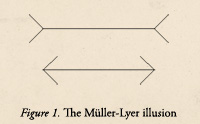 The voice of reason may be much fainter than the loud and clear voice of an erroneous intuition, and questioning your intuitions is unpleasant when you face the stress of a big decision. More doubt is the last thing you want when you are in trouble. The upshot is that it is much easier to identify a minefield when you observe others wandering into it than when you are about to do so. Observers are less cognitively busy and more open to information than actors. Organizations are better than individuals when it comes to avoiding errors, because they naturally think more slowly and have the power to impose orderly procedures. Organizations can institute and enforce the application of useful checklists, as well as more elaborate exercises, such as a reference-class forecasting and the premortem. At least in part by providing a distinctive vocabulary, organizations can also encourage a culture in which people watch out for one another as they approach minefields. Ultimately, a richer language is essential to the skill of constructive criticism. There is a direct link from more precise gossip at the watercooler to better decisions. Decision makers are sometimes better able to imagine the voices of present gossipers and future critics than to hear the hesitant voice of their own doubts. They will make better choices when they trust their critics to be sophisticated and fair, and when they expect their decisions to be judged by how it was made, not only by how it turned out.

Posted by Michael McKinney at 08:21 AM
12.21.11

Doing More With Less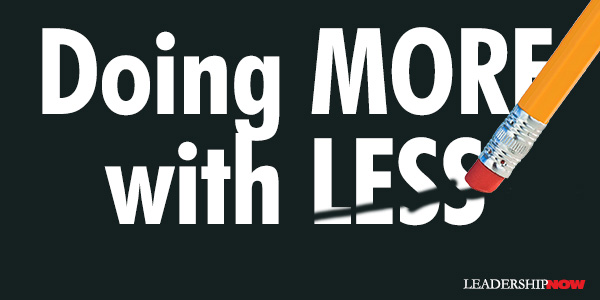 MOST companies are asking employees to do more with less. These demands may produce positive results in the short term, but they are not sustainable in the long term. “Organizations can do more with less simply by not leaving so much untapped performance on the table.” The frustration people often face in these conditions is not an engagement problem; it is more often an enablement problem.
MOST companies are asking employees to do more with less. These demands may produce positive results in the short term, but they are not sustainable in the long term. “Organizations can do more with less simply by not leaving so much untapped performance on the table.” The frustration people often face in these conditions is not an engagement problem; it is more often an enablement problem.
Mark Royal and Tom Agnew of the Hay Group, explain that The Enemy of Engagement is frustration caused by a highly engaged employee’s inability to succeed in a role due to organizational barriers or the inability to bring the bulk of his or her talents, skills, and abilities to the job. Ironically, the more engaged they are, the more frustrated they get because they care more. Doing more with less doesn’t mean conjuring higher levels of motivation out of thin air, but rather allowing motivated employees to perform at their best. It’s about harnessing and unleashing the full potential of frustrated employees—those who want to give their best but can’t due to organizational barriers and constraints. Typically we associate better engagement with leadership, but what drives it is better management. Fixing engagement means dealing with the frustration of thwarted employees. Specific management practices detailed by the authors include:
One of the most actionable things to do is to simply ask: “How can we change things around here to help you be more effective?” By doing so “a manager creates an opportunity for an employee to speak honestly and openly about enablement issues.”

Posted by Michael McKinney at 04:34 PM
12.20.11

5 Leadership Lessons: What if You Could Take Control of Your Life with One Decision?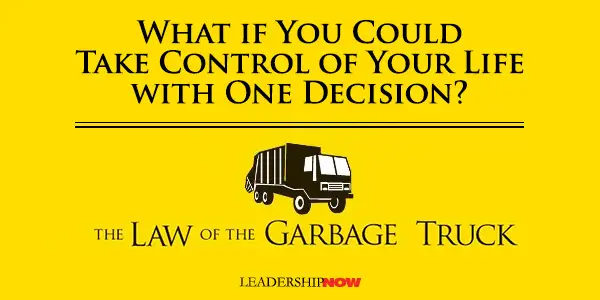
 Many people are like garbage trucks. They run around full of garbage, full of frustration, full of anger, and full of disappointment. As their garbage piles up, they look for a place to dump it. And if you let them, they’ll dump it on you. So when someone wants to dump on you, don’t take it personally. Just smile, wave, wish them well, and move on. Believe me, you’ll be happier. Here are five lessons from David Pollay, to help us to focus on what really matters personally and professionally:

Posted by Michael McKinney at 10:43 PM
12.19.11

Creative People Must Be StoppedMostly people say they want big, new, creative ideas. But when you come up with one, they seem to go out of their way to kill it. They act like creative people must be stopped. Wouldn’t it be nice to know where the opposition is going to come from before you ever present it?In Creative People Must Be Stopped, David Owens suggests that it will come from at least one of six different areas: Individual—your idea may not be that good
Industry-Wide—competitors or even customers torpedo it
Owens presents a framework “that will enable us to see in advance the vital factors that determine our chances for success when we embark on an innovation.” We both lead and manage innovation, says Owens. “Think of the process of innovation as simply a set of steps that will need to be accomplished in order to get from the stage of identifying a problem all the way through to implementing a solution. Along this path, there will be a number of management activities that can smooth progress and make for a more efficient effort.” At the same time, there are leadership-type activities along the lines of emotion, motivation, and mission. He writes: One of the most important leadership skills is to discern whether the person standing in front of you is asking for your help as a manager or for your attention as a leader. Sometimes explaining the plan, clarifying a goal, or acquiring a resource is enough management to keep team members moving along a path. At other times, they may need something significantly different. They may want to understand whether this mission is truly meaningful given that they heard otherwise over the office watercooler. Or they may need help staying motivated in the face of seemingly endless late nights and setbacks in the project. He adds a crucial reminder for leaders as it’s easy for a leader to get to the place where you think, “Why are they questioning me? They should just do!:” Everything we know about leadership suggests that people need reasonable answers to be willing to follow. Of course you can choose not to answer them proactively; but then don’t be surprised when rumor, gossip, and hearsay gathered from around the office watercooler quickly fill the void you have left. David Owens offers a free Organizational Innovation Constraints Assessment on his web site. 
Posted by Michael McKinney at 03:22 PM
12.14.11

Avoid Trivia
CAUGHT UP IN our day-to-day struggles, keeping our eye on the big picture is difficult. We can become distracted by the relatively trivial matters to our larger purpose. To be sure, the daily minutia needs to be dealt with, but the trivia will always be there to deal with, to distract us, to take us off-course, to cause us to doubt and give up. What is important is what you pay attention to. Where you place your attention will determine the course of your life. 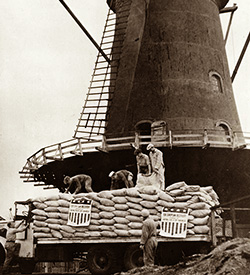 Kennan recalls that he offered no observations or suggestion of his own. When he asked for advice, Kennan writes, “The only advice he had to give me was expressed in two deeply serious and unforgettable words: avoid trivia.” Kennan says when they began they encountered a great deal of skepticism and pessimism. “To every idea we put forward, weighty and often plausible objections were raised. The problem we were told was too great: the resources were not there; the Europeans would never consent to take the initiative; whatever help we might be able to offer would merely sink into the sands.” But their instructions from Marshall were to not listen to those voices—avoid trivia. Those voices are always there in any worthwhile effort we make. The tension between the trivial and the weighty matters is a part of life. Avoid trivia. Stay focused on the weighty matters. Choose the things that capture your attention—be intentional. Avoid the worthless things.
Posted by Michael McKinney at 08:31 PM
12.13.11

7 Keys to Managing Willful Blindness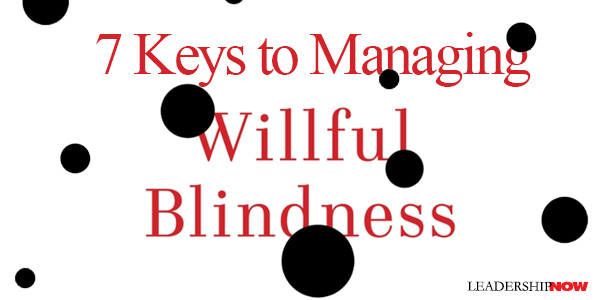
WE can’t escape willful blindness. “It’s a human phenomenon,” admits Margaret Heffernan, “to which we all succumb in matters little and large.” She explains in Willful Blindness, that it doesn’t always bring us to a disastrous end, it also oils the wheels of social intercourse and it is not inevitable but it is persistent. Sometimes we do have the courage to see. “When we confront facts and fears, we achieve real power and unleash our capacity for change.” Our brain likes the familiar. It doesn’t operate in neutral. There’s always a bias. “Our blindness grows out of the small, daily decisions that we make, which embed us more snugly inside our affirming thoughts and values. And what’s most frightening about this process is that as we see less and less, we feel more comfort and greater certainty.” An aspect of willful blindness, self-deception, is the topic of Robert Trivers’ The Folly of Fools. He asks, “Why do we possess marvelous sense organs to detect information only to distort it after arrival?” Although we gather an “exquisitely detailed perception of the outside world, as soon as that information hits our brains, it often becomes biased and distorted, usually without conscious effort.” It’s a fascinating work, but even Trivers can’t help himself from selective recall and arguments molded to fit his own biases here and there. We are all right in our own eyes. It’s difficult to share examples of blindness without exposing our own blindness. Heffernan notes, “when we work hard to defend our core beliefs, we risk becoming blind to the evidence that could tell us we’re wrong.” What can we do to escape our own self-deceptions and willful blindness? Maybe the best we can do is to balance our biases. Heffernan suggests several ways we can manage our blindness: Reexamine Your Life. When we are younger we do it more frequently. But at some point, we stop doing it. “Is it that it gets too draining to keep questioning your life?” Travel between Perspectives. Hannah Arendt calls it “thinking without a banister.” Traveling between points of view can be risky, says Heffernan. “But in the intersection between disciplines, real insight can be gleaned.” Recognize the Homogeneity of Our Lives. Put more effort into reaching out to those that don’t fit in. “Diversity, in this context, isn’t a form of political correctness but an insurance against the internally generated blindness that leaves [our Congress, corporate boards, think tanks and churches] exposed and out of touch.” Know the Limits of Our Cognitive Capacity. Go home. Working long hours taxes our cognitive capacity. Exercise. “The only exercise that seems to nurture, or at least protect, our brains is aerobic exercise.” Seek Disconfirmation. Hire dissent. This is most critical and often the most strongly opposed. “The ability to endure or even welcome debate and conflict requires practice and protection….You need to create a state in which [employees] have the courage to do something. You want to build organizations where everyone sees provocation as one of their essential roles.” Too many leaders are saying, “Why are they questioning me?” or “That’s none of their business.” Get a thinking partner for that third opinion. (See Bill George’s True North Groups.) Professional “third opinion” Saj-Nicole Joni, told Heffernan: Having a small network of people, who will bring you the unvarnished truth and with whom you can have unfettered exploration, are a partial antidote to willful blindness.Heffernan adds: “Outsiders—whether you call them Cassandras, devil’s advocates, dissidents, mentors, troublemakers, fools, or coaches—are essential to any leader’s ability to see.” Challenge Complexity. Provoke skepticism around complexity. “Many organizations view their impenetrability as a feat of fantastic intellectual virtuosity. In reality, it’s a huge cause of blindness and explains why, when such companies get into trouble, they can’t find their way out of it.” Endure the Noise. Silence—fear of debate, fear of debate—becomes self-perpetuating. “Without conflict, everyone remains afraid and blind…We need to celebrate those that make the noise, heroes more inspiring than talent contest winners and drunken movie stars.” Heffernan concludes that seeing starts with simple questions: “What could I know, should I know, that I don’t know? What am I missing here?”

Posted by Michael McKinney at 12:45 PM
12.09.11

3 Ways to Be a Positive Leader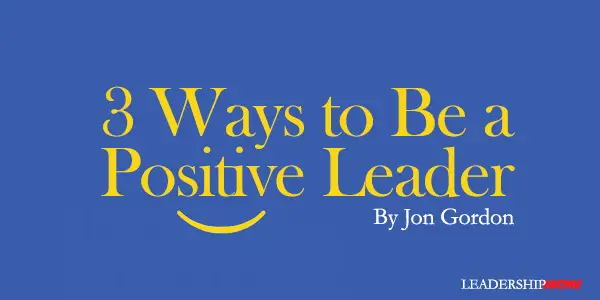
IN A WORLDIn a world filled with busyness and stress, I find that too often leaders can act like hard-charging, fast-driving bus drivers that have a vision and goal within their sights and they’ll run over anyone – even their own employees – to reach their destination. I know this well because early in my business career I was that kind of leader and I have had to work hard to change my approach. I realized that any hard-charging leader can create success in the short term, but it would take a positive leader with a people and process-driven approach to build a successful organization for the long term. As John Maxwell said, “If you are all alone at the top, you are not a leader. You are a hiker.” No one creates success alone. To win in business, you must win with people. Running over people will only get you so far. To create true and lasting success you must nurture and invest in your people. Here are 3 essential ways to do this Care about them – The main question every employee in every organization is asking is, “Do you care about me; can I trust you?” Employees want to know if you care about them. If you do, they will be more likely to stay on the bus and work with you. Employees are more engaged at work and will work at their highest potential when their manager cares about them. Develop a relationship with them – Author Andy Stanley once said, “Rules without relationship lead to rebellion.” Far too many managers and leaders share rules with their people, but they don’t have a relationship with them. So what happens? The people rebel, and they disengage from their jobs and the mission of the team. I’ve had many managers approach me and tell me that my books helped them realize they needed to focus less on rules and invest more in their work relationships. The result was a dramatic increase in team performance and productivity. To develop a relationship with your employees, you need to build trust, listen to them, make time for them, recognize them and mentor them. Appreciate them – The main reason why people leave their jobs is because they don’t feel appreciated. For example, Doug Conant, the CEO of Campbell Soup, has written more than 16,000 thank-you notes to employees in the past seven years and created a very positive business in the process. It’s as easy as saying (or writing) “Thank you.” It’s a simple truth: When you care about your employees and the people you work with, they are more likely to stay on the bus and work harder, with more loyalty and greater positive energy. In turn, they are more likely to share their positive energy with your customers, thus enhancing service and the bottom line. The greatest customer-service strategy has nothing to do with customer service, but it has everything to do with how you treat your employees. If you model great service, they will provide great service. Remember, leadership is not just about what you do, but what you can inspire, encourage and empower others to do. Instead of running over the people in your team/organization, invite them on the bus with you and engage them to help you create an amazing and successful ride.  
Posted by Michael McKinney at 02:06 PM
12.07.11

True North Groups
YOU can’t do it alone. We often try to, imagining that we can see and know the things we need to know without the discerning eye of an outside point of view. Bill George and Doug Baker remind us in True North Groups that, “We need people around us to whom we can look for support and advice, who can help us develop as human beings. We need them to help us become better leaders in our work, our communities, and our families.” It’s easy to get off track. “Most of us know what our True North is, but we are constantly pressured from external sources to deviate from it. Or we are seduced by extrinsic rewards like money, power, and recognition that cause us to detour from our True North.” A True North Group is comprised of six to eight trusted peers who meet on a regular basis to discuss the important questions of their lives and to support each other during difficult times. At various times, each person in the group will serve as a mentor or coach to others. True North Groups are not just about having a place to go to help you with your challenges. Done well, a group will encourage you to make the necessary course corrections that will help you to avoid the avoidable problems we all can get ourselves into. Save us from ourselves so to speak. It’s also a place to share successes.At stake is our own vulnerability. Even if we are afraid of the idea, it’s not difficult to see the value in it. George and Baker have been doing this for decades and share the nuts and bolts of creating your own group. It begins with picking the right people and that may not include your close friends. It’s based on trust and a commitment to personal growth. The authors list the following characteristics of ideal group members:
Next steps include, Norming (establishing how the group functions), Storming (behaviors that may impede your group), Performing (maintaining and renewing your group) and Reforming (the need to restructure and start again). The appendix provides topics for discussion to get your group going and thinking in the right direction. You’ll also find Member Contracts, Ground Rules and other valuable resources for your own True North Group.>/p>

Posted by Michael McKinney at 02:27 PM
12.01.11

First Look: Leadership Books for December 2011Here's a look at some of the best leadership books to be released in December.




For bulk orders call 1-800-423-8273  Build your leadership library with these specials on over 120 titles. All titles are at least 40% off the list price and are available only in limited quantities.
Posted by Michael McKinney at 12:09 AM
|
BUILD YOUR KNOWLEDGE


How to Do Your Start-Up Right STRAIGHT TALK FOR START-UPS 
Grow Your Leadership Skills NEW AND UPCOMING LEADERSHIP BOOKS 
Leadership Minute BITE-SIZE CONCEPTS YOU CAN CHEW ON 
Classic Leadership Books BOOKS TO READ BEFORE YOU LEAD |
|